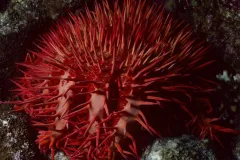A Plague of Sea Stars

Sea stars are important members of marine ecosystems, especially in the tropics. We may think of tropical coral reefs as being home mainly to fish and corals, but in fact these habitats are home to a huge diversity of ecologically important invertebrates.
Sometimes, human influences can throw off the balance between these invertebrates, resulting in a cascade effect that negatively affects the entire coral reef ecosystem.
A case study of this imbalance can be found in the tropical Indo-Pacific crown-of-thorns sea star (COTS). (Scientific name= Acanthaster planci)
Meet the Crown-of-Thorns Sea Star
The COTS bears very little immediate resemblance to those species seen in colder climates. Its entire body surface is covered by sharp, conical, toxic spines that make it very undesirable prey. This species occurs only in the tropical Indian and Pacific Oceans. It is absent from the tropical Atlantic.
The COTS feeds almost exclusively on coral. In a “healthy” setting, the COTS affects the composition of coral species present in a reef and ultimately aids in its overall health.
An Outbreak “Plague” of Sea Stars!
In the mid- to late-1960s, reports from Japan and Australia warned that populations of the crown-of-thorns sea stars had reached “outbreak” proportions. There were increasingly large numbers of COTS that were far in excess of what had been described earlier.
An individual feeds on only 6-12 square meters of living reef per year (that’s about the dimensions of a compact car). But outbreak populations of COTS had risen from about 65 per hectare to between 140 and 1,000 animals per hectare (1 hectare=10,000 square meters). Coral reefs were being threatened by a veritable army of COTS!
The outbreak of COTS had reached such a dire situation that the Australian government formed a “Sea Star Task Force” to address the issue.
Explanations of the COTS outbreak over the years have been controversial. However, a paper by Jon Brodie and coauthors in Marine Pollution Bulletin provides a compelling explanation that may finally provide an answer to the COTS outbreak mystery. Brodie explains the outbreaks as the result of increased nutrient runoff from the land feeding the larval (i.e., “baby”) starfish in the water.
This runoff includes organic sources like sewage, fertilizers, and sediment from agriculture and deforestation, which are discharged into rivers and flow into the ocean. These added nutrients cause blooms in the phytoplankton that the larval COTS fed on while they swim in the water.
The added food creates a domino effect. Under normal conditions, you might have one larva settling to the bottom and becoming an adult animal, but instead, you have about six times MORE of them surviving and thus, settling out to become adults. This results in several orders of magnitude MORE adult predators than the ecosystem would normally support. Voila! You have an outbreak!
Diversity and ecology are interconnected parts of the big conservation picture. Brodie’s study reminds us that an individual species can be intrinsically tied to the overall balance of an ecosystem and external changes can significantly affect that system’s health. Especially when those changes result from an extreme human-produced imbalance.

